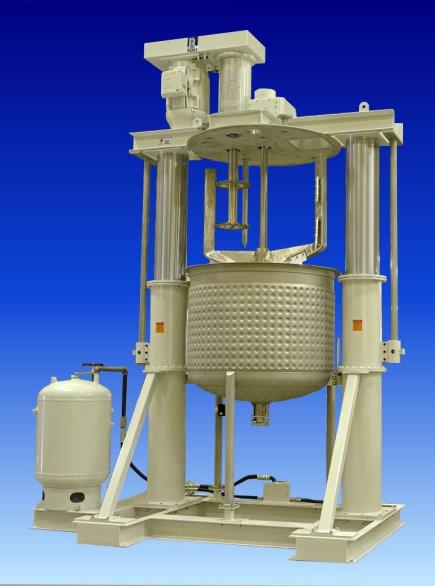Tech Report
Recommended Mixing Equipment For Filter Cake Dispersions

Application Summary
This bulletin describes three mixing technologies commonly utilized in the preparation of filter cake slurries: High Viscosity Dispersers, Dual-Shaft Mixers and Inline High Shear Mixers.
Ross High Viscosity Dispersers
High Viscosity Dispersers, also called Bow-Tie Mixers after the shape of their blades, are standard workhorses for creating filter cake and press cake slurries. Running at relatively low speeds, the bow-tie-shaped agitator is highly efficient at breaking apart large pieces of filter cake and generating a flow pattern that keeps even dense solids uniformly suspended in liquid. At the same time, the mixing action mitigates abrasive wear that can occur when hard particles are present.
The standard design features an air/oil hydraulic lift to raise and lower the agitator into a mix can or drum. This enables convenient product changeovers and simplifies maintenance. It also allows the High Viscosity Disperser to flexibly handle a wide range of batch sizes. For example, a 15 HP model may be used for mixing anywhere from 50 to 500 gallons of slurry, depending on viscosity and density. An adjustable stainless steel can lock system is used to secure various size/diameter vessels and permits on- or off-center vessel placement. Explosion-proof safety limit switches prevent operation of the mixer while in the raised position or without a mix vessel in place.

Ross Dual-Shaft Mixers and Inline High Shear Mixers
Dual-Shaft Mixers are also widely used for dispersing different kinds of filter cake materials and preparing high solids fluidized slurries. Equipped with two independently-driven agitators working in tandem, Dual-Shaft Mixers deliver a unique combination of high speed agitation and laminar bulk flow.
An economical yet robustly designed machine, the Ross Dual-Shaft Mixer features an anchor agitator and a high speed disperser. Turning at tip speeds around 5,000 ft/min, the saw-tooth disperser blade creates a vigorous vortex that wets out powders, pellets or irregular pieces of filter cake solids as they are added into water or any appropriate solvent, frequently in the presence of a dispersant. Loose agglomerates are rapidly broken down to individual particles. The low-speed sweeping action of the anchor agitator enhances the exchange of materials within the vessel, continuously "feeding" the high-speed blade with fresh product.
The disperser shaft may be supplied with two or more blades to promote short cycle times especially in very large Dual-Shaft Mixers. If the filter cake solids being resuspended are particularly abrasive, the high-speed blades can be fabricated from wear-resistant material such as ultra-high molecular weight (UHMW) polyethylene. Intense mixing may impart heat to the slurry so temperature must be carefully monitored, preferably using a thermoprobe installed through the mixer cover and in contact with material from the center of the batch. Self-adjusting scrapers attached to the anchor agitator are often useful because they improve heat transfer across the vessel jacket filled with running cooling water. Vacuum may be applied during the last stages of mixing to achieve a smooth slurry with no air bubbles.
For added versatility and shear capability, an inline rotor/stator mixer may be installed on a recirculation line piped to the Dual-Shaft Mixer. In such set-ups, Ross High Shear Mixers and Ultra-High Shear Mixers are ideal for non-abrasive filter cake dispersions requiring a very tight particle size distribution.
